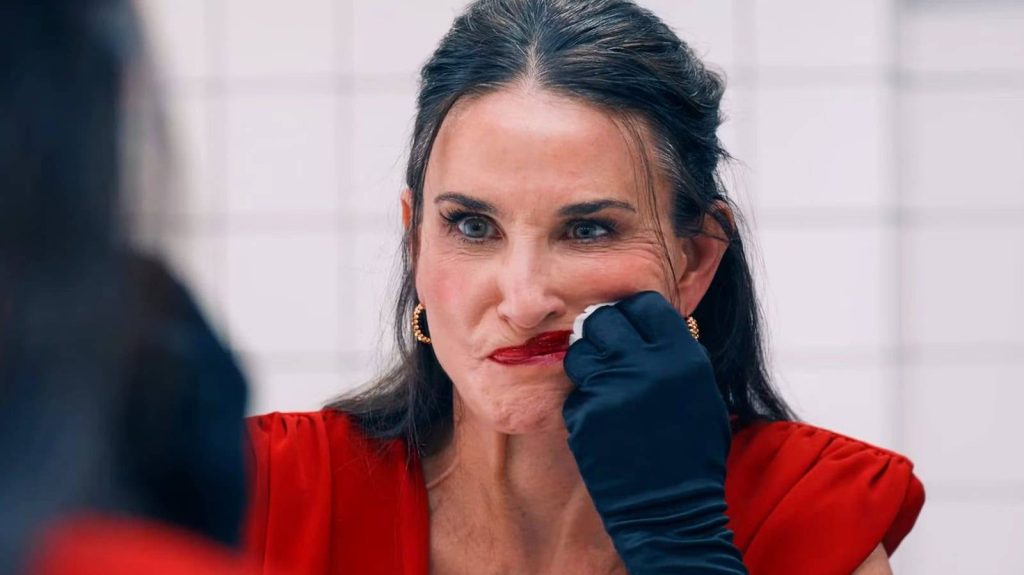Have you ever been a woman trying to escape the suffocating grip of societal pressures on appearance? I certainly am one. Feeling insecure about body weight, wrinkles, hyperpigmentation, hair, skin, etc., seems to be present like never before in most women. Never had it been as bad as it is now. Let me elaborate, if you read my article about eating disorders you’ll remember I said eating disorders increased in the 1960s with the rise of overconsumption and publicity. Eating disorders are linked to Body Dysmorphia, which has also increased even more since the 1960s. Take the early 2000s, for instance, when the “heroin-chic” look was idolized. Images of dangerously underweight models battling substance abuse were plastered across popular magazines, reinforcing harmful ideals.
Starting the decade of 2010-2020 it felt as if those harmful expectations were finally drifting away from society. As if people were healing, finally opening to various body types, especially normal levels of abdominal fat. Lo and behold, with the expectations of big boobs, big butts, flat abdomens, fillers, and the rise of BBL (Brazilian Butt Lift) procedures; we were once again far from health. Society wasn’t just chasing impossible body idealsanymore —it was normalizing extreme measures to achieve them.
By 2020, public figures—like the Kardashians—abandoned their once-iconic curvy physiques. Instead, the return of the “heroic chic” body, as well as Y2K garments, and the idolization of models and stars consuming substances. The rise of Ozempic for weight loss, Botox, an insatiable fixation on skincare all over the media, and the overnight changes in celebrities who once preached “Body Positivity”, reveal how far we are from collective self-esteem and actual healthy bodies. This has only amplified the insecurities of everyday women. Body positivity, which seemed so hopeful, now feels like a fleeting memory.
The Substance and Society’s Objectification of Women
The Substance is a film written and directed by Coralie Fargeat, starring Demi Moore and Margaret Qualley. It explores societal standards, what it means to be attractive, and how it will impact women’s daily lives. Not only if they want to pursue a career in the entertainment industry, but also how overall men mainly view women as objects of desire. It’s no coincidence all the producers, bosses, and leaders in the film are men. At the end of the day, most people in positions of power are men, and whether we like it or not, many of them focus on their female employees’ physical attributes before their skills.
The film’s critique revolves around men’s objectification of women and how it spills through society until women are the ones perpetuating those standards as well. Nowadays, as a woman, the prettier you are, the more “valuable” you’ll be, and the more you’ll sell. Not only do men producing want women to fit a certain stereotype, but the men who consume expect such a stereotype. This perpetuates harmful stereotypes, further reinforced by media and entertainment, and encourages compulsive behaviors rooted in self-hatred.

Compulsion, Body Dysmorphia, and the Pursuit of Perfection
With cosmetic surgery trends 2024, modern science, and technology, it doesn’t matter if you hate yourself or your appearance, you can now find any procedure to fix or change parts of your body. As someone who constantly looks in the mirror, I can tell you I often feel insecure about myself. The way I act, the way I speak, and the way I might come across. It’s almost as if I’m trying to portray the perfect appearance to other’s expectations so that I won’t have to deal with their judgments. I am hypervigilant of people’s opinions, and I am terrified of rejection. I do have to say that I grew up with very judgmental parents, even though I’ve worked on this in therapy for years, I still can’t fully accept and free myself from a third party’s opinion of me.
In my experience, when I’m at my lowest—feeling inadequate in my work or personal life—I turn to the mirror. I obsessively examine my skin, searching for flaws to fix. Then I pick my skin with tools, nails, products, or makeup in a futile attempt to achieve an illusion of improvement. But, in reality, this only leads to more dissatisfaction. It’s a vicious cycle that spirals into deeper insecurity.
This is exactly how it was portrayed in the scene of Demi Moore rubbing makeup all over her face in front of the mirror. Even though we can have an illusion of improvement, we only ruin and damage our skin even more. Anger increases and self-harm as well. We only end up throwing a temper tantrum aggressively rubbing our faces and feeling impotent.
Dr. Tracey Marks describes Body Dysmorphic Disorder as a “brain disorder that creates faulty and inaccurate perceptions about your appearance. For some people you can even have delusional beliefs that make you think the flaws you see are an accurate perception.” She proceeds to give an example of a woman who feels insecure about her nose. She is convinced her nose is gigantic, and although people tell her she looks good, she is convinced she looks hideous. She believed everyone at work thought she looked ugly and talked about it behind her back.
This is a clear behavior in Elisabeth Sparkle. She stares at the mirror convinced everyone is talking about how ugly and old she looks. She stares at her eyes, her wrinkles, her skin, her hair, almost in search of any imperfection she should fix. However, what happens when the idea of others commenting on your looks is not an illusion but a fact? Elisabeth was a popular actress and the producers and business owners from the production company judged her looks. In 2024, everyone is obsessed with their image, partly because the rates of BDD have increased, but also because bodies and appearances keep getting attention from the media. Take a look at mainstream shows like Fashion Police and the harm they caused to the public. Even though it’s no longer on-air, the talk show was about commenting the styles of celebrities. The aim was to provide insight on what should be stylish or not, but many times the hosts made cruel comments about the actresses’, models’, and female public figures’ bodies or age.

The Substance’s Powerful Message on Self-Hatred
The Substance highlights societal pressures to be perfect and the toll it takes on people, leading to eating disorders or Body Dysmorphia. Most importantly, the movie portrays how a coping mechanism towards those disorders is compulsion. This also reminds me of Requiem for a Dream when Sara Goldfarb ingests weight loss pills until it becomes an addiction.
In The Substance, Elisabeth becomes obsessive about being perfect, and her impatience, delusion, and misery drive her to destroy her body even more by submitting to a painful mitosis-like procedure. The craziest part is how Elisabeth and Sue keep forgetting they are the same person, almost like the egoism of young people who are too self-absorbed trying to enjoy their youth without thinking about their future selves. As people grow old, they change and they overcome several challenges, often becoming a new self. In a way, our old and young selves are different, almost like different people. Our outlook on life might be different as well as our habits, goals, and the things we desire. The most haunting thing about being young is that you try to make the most out of your youth while harming your healthy body, spending money as if it were eternal, and pursuing pleasure before building things that will pay back for your future selves. For example, how Sue is ruining Elisabeth’s body and accelerating aging to the point where Elisabeth can’t walk.
In the end, Sue kills Elisabeth until she realizes she hates herself even more, she is aging as well and has now become Elisabeth. She takes the substance again and a fully mutated woman is born. The difference is that this new woman as ugly as she is, is still pursuing the same goal submitting to painful and unrealistic standards. She is so deluded that she can’t even process how deformed she is, and she only wishes to feel appreciation from the audience at her New Year’s broadcast as if that would fill her massive void of self-hatred with love. This proves how The Substance’s most profound theme was more than BDD or compulsion, but rather self-hatred. And how the older you get, the more you embrace your younger self. Many times, we hate or dislike ourselves when we are young until we grow older and realize how wrong our thoughts about ourselves are. But it doesn’t matter if by 40 you embrace your 20-year-old self if you are still abusing and judging your 40-year-old self. It’s a never-ending cycle of self-hatred.
The biggest takeaway from The Substance? If our older selves could embrace who we are now, why can’t we? One of the best remedies that I´ve come across to cure self-hatred is as soon as I’m feeling ugly, fat, deformed, with one eye bigger than the other, huge pores, a big double chin, fat thighs, ugly cellulite, and obvious stretch marks, I whisper to myself -“I’m thinking about myself too much”. Perhaps sometimes we need to let those intrusive thoughts go, sometimes we just need to stop thinking about ourselves and walk away from the mirror. Elisabeth’s compulsion and self-abuse got worse as soon as she had a date with Fred, she stood him up because she thought she was ugly. Maybe Elisabeth would’ve felt better about herself if she had walked away from that mirror and bravely faced her date. She might have felt seen and accepted by him, as if she had never become “outdated”.






Your point of view caught my eye and was very interesting. Thanks. I have a question for you. https://www.binance.com/en-NG/register?ref=YY80CKRN
Không chỉ có giao diện đẹp mắt, slot365 link alternatif còn cung cấp các luật chơi rõ ràng, dịch vụ hỗ trợ nhanh chóng và chuyên nghiệp, đảm bảo mang lại trải nghiệm tốt nhất cho người chơi thông thái. TONY12-15